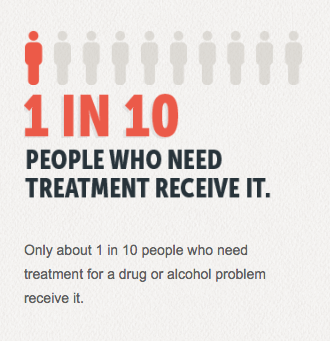NPR reported on a new implant version of Buprenorphine, the modern version of methadone. The human face of the piece is Dave, a paramedic who was on Buprenorphine for a few years, and has now been a test subject for the injectable version of the drug for the past year. They mentioned that Dave said he was thinking of weaning off these drugs–and then the article ends with this rare accidental moment of clarity:
“But then, the more I think about it [getting off the drugs], it scares the hell out of me,” he says. “I’m scared of going backward. I honestly don’t know what would happen.”
That’s a fear voiced by many of the growing number of Americans who have come to see their addiction as a chronic disease, a condition they may have to live with — and need treatment for — for many years. [emphasis added]
Such fear is absolutely toxic, and hazardous to your health. The disease model actually hurts people by instilling this fear, and decreases their chances for success. Don’t believe me? Superstar addiction researcher William R Miller tested all sorts of factors to find out if he could predict who would relapse following outpatient treatment for alcohol dependency. Two factors stood out as “optimally predictive of resumed drinking”, one of which was “belief in the disease model of alcoholism.”
Another well designed study found that exposure to the 12 step program with its disease model teachings led to increased binge drinking upon follow up. The increases weren’t minor either. The subjects who learned to see their drinking as a disease were 9 times more likely to binge than those assigned to a CBT self help group that didn’t teach the disease model (and in fact taught some things that were conceptually contradictory to the disease model), and the disease group also became 5 times more likely to binge drink than a control group who received no help. To sum up, exposure to the disease model led to increased binge drinking.
These results shouldn’t be surprising. We all know someone who went to rehab and got worse. The fear instilled by teaching people to see their problems as being caused by the mysterious disease of addiction–is one major preventable source of their ongoing problems. It’s time to dump the disease model, and treat people like the competent self-determining human beings they are. If we want to help them, we should provide them with solid information–not hysterical lies that instill fear.

The truth is that Dave doesn’t need to fear being a patient in need of addiction treatment for the rest of his life because in fact he doesn’t need treatment for the rest of his life (and doesn’t need it to begin with, but that’s a point for a different blog post). Plenty of general population studies have shown that most “addicts” will recover–about 9/10 of them– and that addiction rapidly decreases with age, demonstrating that people do indeed get over it, and that while some people certainly stumble on the way, it isn’t in fact a “chronic relapsing disease.” In reality it’s just a phase. Yet they keep teaching people this disease nonsense and filling them with fear.
Did you have fear based drug education in school when you were a child? How well did that work? Well, the recovery culture works in the exact same way. They try to scare people away from substance use, and it just doesn’t bring good results. Even with a case like Dave, who is currently free of problematic opiate use, he is still living with unnecessary painful fear.
These opiate addiction medications are the wrong way to go in the long run. Get a taste of why that is from my article The Misguided Obsession with Heroin / Opiate Maintenance Drugs (Suboxone, Subutex, Buprenorphine, Methadone). The basic reason for this is that the use of these drugs–even if they are a part of a successful quit attempt–teaches the disease model implicitly. The entire premise of long term use of these drugs (rather than short term detoxification use) is that they restore some permanent deficit in the brain of the opiate user that causes them to desire opiates–and thus decrease cravings. In fact they only take away physical withdrawal, which is a temporary condition that can resolve within three to 14 days in the absence of opiates.
Any craving that anyone does for drug use will never be changed pharmaceutically. It will only be changed cognitively, because craving is simply wanting a thing. We want because we see something as sufficiently beneficial in comparison to other options. The way to stop wanting is to re-evaluate the thing you want (and/or your other options) and come to see it as not sufficiently beneficial in comparison to other options. I don’t crave a Pentium processor desktop running windows 95 because I see my Macbook Air as far superior. Get it?
It takes real cognitive work to change a preference for heavy drug use. People often do this work without realizing while on Buprenorphine or some other MAT, and then they attribute the decreased craving to the pharmaceutical. That’s too bad. But what’s worse is that sometimes people don’t re-evaluate, and they keep the preference close to completely intact. They’re on the edge with it. They’re just barely on the side of preferring life without the heavy drug use, but they could switch in an instant. Again, they attribute their change to the pharmaceutical; but when they shift their mind to using, they believe the drug has now failed them, and that they are hopeless cases. In the long run, this makes successful resolution of their problems harder, because it’s distracting them from the true source of their desire for heavy substance use.
“Failing” with these treatments makes success harder and harder to find–and people fail often with these treatments. The perfect analog to this, as Stanton Peele has often pointed out, is in nicotine replacement therapies (or NRT – patches, gum, lozenges, etc). The best available research has shown that NRT has low success rates, and that those who try to quit cold turkey succeed sooner, while those who try to quit with NRT struggle longer, and have more relapses. So the theory I’m presenting here isn’t baseless speculation; there is good reason to believe we’d be better off without these medications. They teach people to live in fear and fail. Again, NPR accidently summed it up perfectly:
Dave, the New England paramedic in recovery, says he’s thought about trying to wean himself off the treatment drugs altogether.
“But then, the more I think about it, it scares the hell out of me,” he says. “I’m scared of going backward. I honestly don’t know what would happen.”
That’s a fear voiced by many of the growing number of Americans who have come to see their addiction as a chronic disease, a condition they may have to live with — and need treatment for — for many years.
I want to teach people they can change, prosper, and live in excitement of an improving life. I want to show them they don’t have a disease, they don’t need treatment, and they are capable of/will be the source of their own positive growth and change. I want to teach them this because it is the truth.
